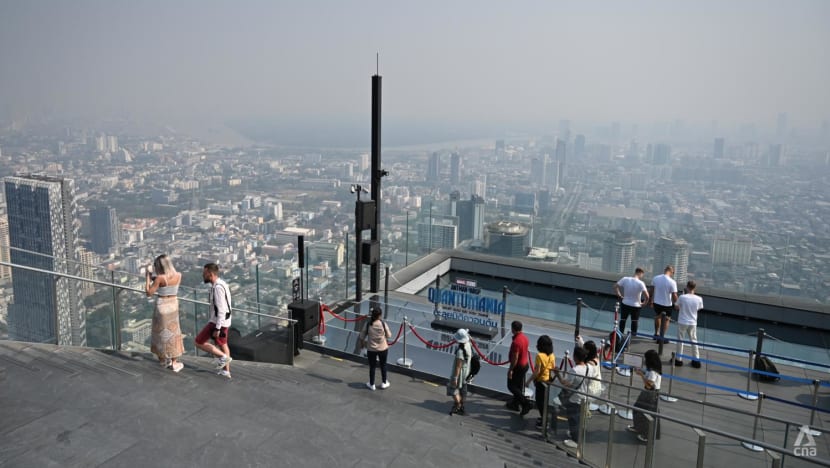Only 2.7% of Southeast Asia cities breathed 'healthy' air in 2022: Report
Only eight out of 296 regional cities in Southeast Asia - where data is recorded - met the World Health Organisation’s guideline for PM2.5 last year. PM2.5 are tiny particles that can cause serious health problems.

Tourists visit the observation deck atop the King Power Mahanakhon Building in central Bangkok for a panoramic view of the city on Feb 1, 2023. (Photo: CNA/Pichayada Promchertchoo)
BANGKOK: Just a tiny fraction of regional cities in Southeast Asia recorded air quality levels in 2022 that meet international health standards, according to a new report from IQAir, a company that tracks air pollution worldwide.
According to its most recent report published on Tuesday (Mar 14), only 2.7 per cent of cities within the region - eight cities out of 296 where data is recorded - met the World Health Organisation’s (WHO) guideline for PM2.5.
PM2.5 are tiny particles that can cause serious health problems. It is one of the deadliest forms of air pollution with a diameter of less than 2.5 micrometres.
These particles can penetrate deep inside the lungs, where they either remain for long periods or pass into the bloodstream unfiltered.
Prolonged exposure to harmful air pollution is known to weaken resistance to respiratory diseases and can heighten the risks of lung cancer and heart disease.
It can be caused by multiple sources, but in Southeast Asia the leading polluters were industry emissions, power generation, vehicle emissions as well as open burning, IQAir said in its report.
Indonesia recorded the highest regional pollution levels, with six of its cities in the top 15 for highest PM2.5 concentrations, including the top-ranked Pasarkemis in Java’s Banten province, and major metropolises Jakarta and Surabaya placing fourth and seventh on the most polluted regional list.
Vietnam’s Hanoi ranked second while Laos’ capital Vientiane was the 14th most polluted city last year.
Overall air quality, however, improved throughout Southeast Asia last year, with seven of nine countries in the region recording a decrease in PM2.5 concentrations across the year. Only Vietnam and Laos saw air pollution levels worsen.
Three Indonesian cities also placed in the “healthy” range of 0-5 micrograms per cubic metre - the measurement of concentration of air pollutants. Those were Kupang in East Nusa Tenggara province, Pangkal Pinang in the Bangka Belitung Islands Province and Mamuju in West Sulawesi.
The region’s best air quality was in Nam Sach, a rural district in the Red River Delta region of Vietnam, according to the survey by IQAir.
GLOBAL AIR POLLUTION WORSENS
Despite Southeast Asia’s relative improvements in tackling air pollution, the situation has generally worsened around the world, the IQAir report found.
Only 13 countries or territories experienced healthy levels of PM2.5 in 2022. These include Australia, New Zealand, Finland, Estonia and Iceland.
The highest concentrations of PM2.5 were recorded in Chad, Iraq, Pakistan, Bahrain and Bangladesh.
In 2021, the WHO tightened what it considered to be an acceptable level of exposure to PM2.5, cutting it from 10 to five µg/m3. The WHO has stated that 7 million preventable deaths occur each year as a result of air pollution, while countless others have their quality of life impacted.
Of the entire global population, 99 per cent of people breathe air that exceeds WHO air quality limits.
The full picture of how bad air quality is in some regions and countries is also still unclear. While the number of cities that record air pollution data is ever increasing - up to 7,323 cities in 131 countries in this report - there are still significant gaps, particularly in developing nations.
“Too many people around the world don’t know that they are breathing polluted air,” Aidan Farrow, a senior air quality specialist from Greenpeace International said in a statement.
“Air pollution monitors provide hard data that can inspire communities to demand change and hold polluters to account, but when monitoring is patchy or unequal, vulnerable communities can be left with no data to act on. Everyone deserves to have their health protected from air pollution,” said Farrow.
Separately, the global chief executive officer of IQAir Frank Hammes said that last year, more than half of the world’s air quality data was generated by grassroots efforts.
“When citizens get involved in air quality monitoring, we see a shift in awareness and the joint effort to improve air quality intensifies.
“We need governments to monitor air quality, but we cannot wait for them,” said Hammes.
According to IQAir, data for its report was gathered from multiple ground-level air quality monitoring stations. These stations are operated by governments, non-governmental organisations, educational institutions as well as individual citizens.
It added that most of the air quality data used in the report was collected in real time, with supplementary air quality information taken from year-end data sets.
The Swiss firm has previously collaborated with the United Nations Environment Programme (UNEP) to launch the world’s largest air quality data platform.
















